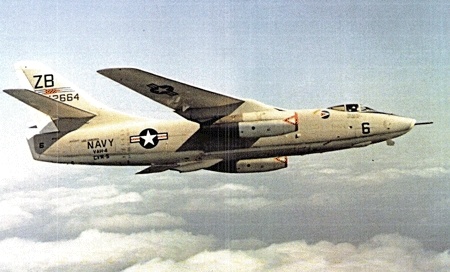The A-3 Skywarrior Memorial Foundation is on a mission to “save the whale,” and they’re not talking about a large marine mammal.
This whale is an 82,000-pound (at maximum takeoff weight), 76-foot-long jet better known as the A-3. It’s recognized as the largest and heaviest bird to ever operate from Naval aircraft carriers.
Bill Burklow, a member of the Whidbey Island A-3 Skywarrior Memorial Foundation, describes the jet as “a bomber originally assigned as a nuke carrier that was designed and developed for the Cold War.”
The jet also provided aerial refueling during the Vietnam War, he said, which resulted in saving countless battle-damaged aircraft that would have been lost for lack of fuel.
Aviators flew the A-3 out of Whidbey Island Naval Air Station from 1957 to 1968. The Navy officially retired the jet from service in 1991.
Only six airworthy A-3s remain, of the 283 that were produced, according to Helen Watson of the Naval Aviation Museum in Pensacola, Fla. There are more A-3s around, but they’re not able to fly, which means they’re more difficult and expensive to move.
The museum expects to loan about six planes, but that’s only an estimate until the strike board determines the official number of planes that’ll be available in June 2010, she wrote in a letter to the Whidbey-based foundation.
Capt. Gerral David, NAS Whidbey commanding officer, is working with the A-3 Skywarrior Memorial Foundation so they have the information they need to develop plans and funding to obtain, display and maintain the aircraft.
“We’re excited about the prospect of having an A-3 Skywarrior on static display at NAS Whidbey Island. It’s just one more way we can proudly preserve our naval aviation history,” said David.
David has approved the location for a static display on the corner of Langley Boulevard and Ault Field Road, if the base receives an A-3.
The foundation is currently working on a design concept and business plan that they’ll submit to the air station’s public works committee, Burklow said. And then it’s a waiting game.
Whidbey Island is as ideal place for this type of display, he said, because of its sizable retired naval community that includes many former A-3 pilots, engineers and mechanics.
The foundation’s chances of receiving a plane are good, Burklow said, because naval air stations are given priority. According to Watson of the Naval Aviation Museum, NAS Whidbey is at the top of the list.
The Naval Museum in Pensacola could assign an A-3 to NAS Whidbey as early as June 2010. Members of the Skywarrior Memorial Foundation hope to celebrate the aircraft’s arrival – when and if NAS Whidbey receives the jet – with a “fly in” ceremony before the plane is converted to static display.
The A-3 Skywarrior Memorial Foundation is aiming to have this Static Display in place and dedicated by the 100th Anniversary of Naval Aviation in 2011.
Such a monument could be another tourist attraction to this area, would be an asset to the local economy and a memorial to those sailors who served this community during the 1950s and 1960s, Burklow said.
For more information about the A-3 Skywarrior Memorial Foundation’s “Save the Whale” campaign, or to donate, visit www.a3skywarrior.com and click on “Whidbey Project” or check out the donation form below. The group’s fundraising goal is $100,000, and all donations will be used for aircraft acquisition, refurbishing and site construction.



